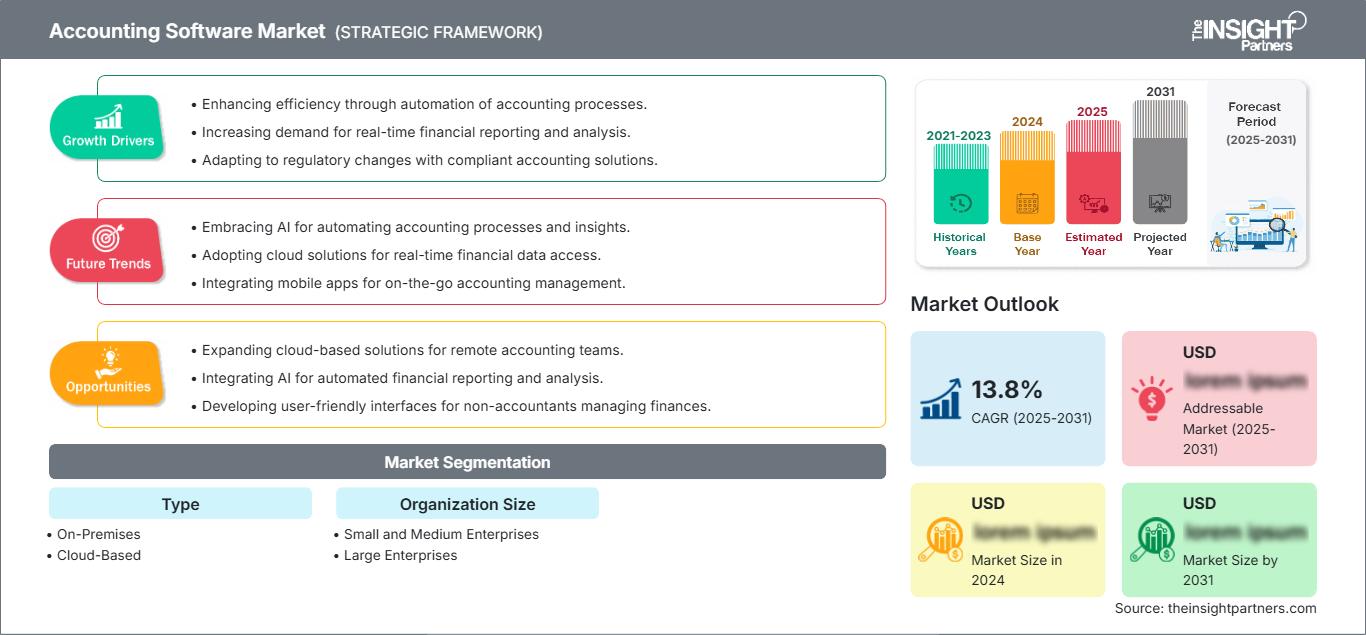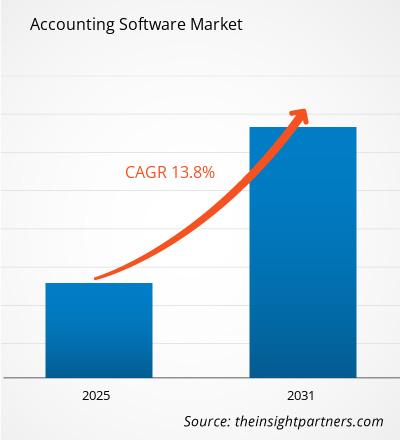Der Markt für Buchhaltungssoftware wird voraussichtlich zwischen 2025 und 2031 mit einer durchschnittlichen jährlichen Wachstumsrate (CAGR) von 13,8 % wachsen. Mobile-First-Ansätze und KI-gesteuerte Automatisierung dürften die wichtigsten Markttrends sein.
Marktanalyse für Buchhaltungssoftware
- Der Markt für Buchhaltungssoftware wächst rasant, angetrieben vom Bedarf der Unternehmen nach einer effektiven Finanzverwaltung. Cloudbasierte Lösungen sind skalierbar und zugänglich, und Automatisierung reduziert Fehler und spart Zeit.
- Die Kombination aus KI und maschinellem Lernen eröffnet Perspektiven für verbesserte Analysen und Prognosen. Schwellenmärkte mit schnell wachsenden KMU-Sektoren bieten enorme Wachstumschancen. Es besteht auch eine steigende Nachfrage nach branchenspezifischen Lösungen, die auf spezifische Buchhaltungsanforderungen zugeschnitten sind.
- Mobile-First-Techniken tragen dem wachsenden Trend zu Remote-Arbeit und mobilem Management Rechnung. Die Integration der Blockchain-Technologie in die Finanzbuchhaltung könnte die Sicherheit und Transparenz verbessern und neue Innovationsmöglichkeiten im Bereich der Buchhaltungssoftware eröffnen.
Marktübersicht für Buchhaltungssoftware
- Buchhaltungssoftware umfasst Computeranwendungen, die Unternehmen und Privatpersonen bei der Erfassung, Verarbeitung und Analyse von Finanztransaktionen unterstützen. Diese Software automatisiert eine Vielzahl von Buchhaltungsfunktionen wie Buchführung, Rechnungsstellung, Lohn- und Gehaltsabrechnung, Finanzberichterstattung und Steuererklärung.
- Buchhaltungssoftware ist ein vielfältiger Markt mit Lösungen, die von einfachen Tools für kleine Unternehmen bis hin zu komplexen Enterprise-Resource-Planning-Systemen (ERP) für Großunternehmen reichen. Diese Lösungen zielen darauf ab, die Genauigkeit, Effizienz und Compliance von Finanzmanagementverfahren zu verbessern.
Passen Sie diesen Bericht Ihren Anforderungen an
Sie erhalten kostenlos Anpassungen an jedem Bericht, einschließlich Teilen dieses Berichts oder einer Analyse auf Länderebene, eines Excel-Datenpakets sowie tolle Angebote und Rabatte für Start-ups und Universitäten.
Markt für Buchhaltungssoftware: Strategische Einblicke

-
Holen Sie sich die wichtigsten Markttrends aus diesem Bericht.Dieses KOSTENLOSE Beispiel umfasst Datenanalysen, die von Markttrends bis hin zu Schätzungen und Prognosen reichen.
Markttreiber und -chancen für Buchhaltungssoftware
Einführung cloudbasierter Lösungen
- Der Übergang zu cloudbasierten Buchhaltungssystemen ist ein wichtiger Treiber im Markt für Buchhaltungssoftware. Cloudbasierte Alternativen verdrängen aufgrund ihrer Benutzerfreundlichkeit, Skalierbarkeit und Kosteneffizienz zunehmend traditionelle On-Premise-Software.
- Der wachsende Bedarf an Remote-Arbeitsmöglichkeiten und Echtzeit-Zugriff auf Finanzdaten treibt diesen Wandel voran. Die zunehmende Nutzung cloudbasierter Buchhaltungslösungen schafft erhebliche Chancen für Softwareentwickler und Dienstleister.
- Unternehmen, die leistungsstarke, sichere und benutzerfreundliche Cloud-Plattformen anbieten, können einen wachsenden Markt kleiner und mittlerer Unternehmen erschließen, die nach kostengünstigen, flexiblen Buchhaltungslösungen suchen.
- Diese Lösungen können um Funktionen wie KI-gestützte Analysen, automatisierte Berichte und die Integration mit anderen Unternehmensystemen erweitert werden.
- Darüber hinaus besteht das Potenzial, branchenspezifische Cloud-Buchhaltungssysteme zu entwickeln, die auf die spezifischen Bedürfnisse von Branchen wie dem Gesundheitswesen, dem Einzelhandel oder der Fertigung zugeschnitten sind und Unternehmen in diesem sich wandelnden Markt einen Wettbewerbsvorteil verschaffen.
Mobile-First-Buchhaltungslösungen
- Die zunehmende Verbreitung von Smartphones und Tablets in Unternehmen hat große Chancen auf dem Markt für Buchhaltungssoftware geschaffen. Da immer mehr Berufstätige für ihre Arbeit auf mobile Geräte angewiesen sind, steigt die Nachfrage nach Buchhaltungssoftware, die auf Smartphones und Tablets die volle Funktionalität bietet, statt abgespeckter Versionen von Desktop-Apps.
- Diese Chance besteht darin, intuitive, funktionsreiche Buchhaltungs-Apps zu erstellen, mit denen Benutzer unterwegs ihre Finanzen verwalten, Rechnungen erstellen, Ausgaben verfolgen und Berichte generieren können.
- Anbieter von Buchhaltungssoftware können die Anforderungen von Kleinunternehmen, Freiberuflern und mobilen Mitarbeitern erfüllen, die Wert auf Flexibilität und schnellen Zugriff auf Finanzdaten legen, indem sie den Schwerpunkt auf ein Mobile-First-Design legen. Diese Strategie kann dazu beitragen, ein wachsendes Segment technisch versierter Kunden zu gewinnen und so den gesamten Markt für Buchhaltungssoftware zu erweitern.
Segmentierungsanalyse des Marktberichts für Buchhaltungssoftware
Die wichtigsten Segmente, die zur Ableitung der Marktanalyse für Buchhaltungssoftware beigetragen haben, sind Typ und Unternehmensgröße.
- Nach Typ ist der Markt in „On-Premises“ und „Cloud-basiert“ segmentiert.
- Basierend auf der Unternehmensgröße ist der Markt in kleine und mittlere Unternehmen sowie große Unternehmen segmentiert.
Analyse der Marktanteile von Buchhaltungssoftware nach Geografie
Basierend auf der Region ist der Markt in Nordamerika, Europa, Asien-Pazifik, Naher Osten und Afrika sowie Süd- und Südamerika segmentiert. Mittelamerika.
- Der Marktbericht für Buchhaltungssoftware enthält eine detaillierte Analyse von fünf großen geografischen Regionen, einschließlich der aktuellen und historischen Marktgröße sowie Prognosen für 2021 bis 2031. Er deckt Nordamerika, Europa, den asiatisch-pazifischen Raum (APAC), den Nahen Osten und Afrika (MEA) sowie Süd- und Mittelamerika ab.
- Jede Region ist weiter in entsprechende Länder unterteilt. Dieser Bericht bietet Analysen und Prognosen für mehr als 18 Länder und deckt die Marktdynamik von Buchhaltungssoftware ab, wie z. B. Treiber, Trends und Chancen, die die Märkte auf regionaler Ebene beeinflussen.
- Darüber hinaus umfasst der Bericht eine PEST-Analyse, die die Untersuchung der wichtigsten Faktoren umfasst, die den Markt für Buchhaltungssoftware in diesen Regionen beeinflussen.
Regionale Einblicke in den Markt für Buchhaltungssoftware
Die Analysten von The Insight Partners haben die regionalen Trends und Faktoren, die den Markt für Buchhaltungssoftware im Prognosezeitraum beeinflussen, ausführlich erläutert. In diesem Abschnitt werden auch die Marktsegmente und die geografische Lage in Nordamerika, Europa, dem asiatisch-pazifischen Raum, dem Nahen Osten und Afrika sowie Süd- und Mittelamerika erörtert.
Umfang des Marktberichts zur Buchhaltungssoftware
| Berichtsattribut | Einzelheiten |
|---|---|
| Marktgröße in 2024 | US$ XX million |
| Marktgröße nach 2031 | US$ XX Million |
| Globale CAGR (2025 - 2031) | 13.8% |
| Historische Daten | 2021-2023 |
| Prognosezeitraum | 2025-2031 |
| Abgedeckte Segmente |
By Typ
|
| Abgedeckte Regionen und Länder |
Nordamerika
|
| Marktführer und wichtige Unternehmensprofile |
|
Dichte der Marktteilnehmer für Buchhaltungssoftware: Verständnis ihrer Auswirkungen auf die Geschäftsdynamik
Der Markt für Buchhaltungssoftware wächst rasant. Die steigende Nachfrage der Endnutzer ist auf Faktoren wie veränderte Verbraucherpräferenzen, technologische Fortschritte und ein stärkeres Bewusstsein für die Produktvorteile zurückzuführen. Mit der steigenden Nachfrage erweitern Unternehmen ihr Angebot, entwickeln Innovationen, um den Bedürfnissen der Verbraucher gerecht zu werden, und nutzen neue Trends, was das Marktwachstum weiter ankurbelt.

- Holen Sie sich die Markt für Buchhaltungssoftware Übersicht der wichtigsten Akteure
Marktnachrichten und aktuelle Entwicklungen im Bereich Buchhaltungssoftware
Der Markt für Buchhaltungssoftware wird durch die Erhebung qualitativer und quantitativer Daten aus Primär- und Sekundärforschung bewertet, die wichtige Unternehmenspublikationen, Verbandsdaten und Datenbanken umfasst. Einige der Entwicklungen auf dem Markt für Buchhaltungssoftware
sind nachfolgend aufgeführt:- Eleven, ein Startup-Innovator im Bereich cloudbasierter Buchhaltungssoftware, hat eine spannende Produkteinführung bekannt gegeben. Eleven stellte eine neue Reihe revolutionärer, KI-gestützter Software vor, die speziell entwickelt wurde, um Buchhaltungsfirmen auf eine noch höhere Betriebseffizienz vorzubereiten und gleichzeitig das Leistungsspektrum auf neue Ebenen der Entscheidungsfindung auszudehnen. (Quelle: Business News Daily, Newsletter, Mai 2024)
Bericht zum Markt für Buchhaltungssoftware: Abdeckung und Ergebnisse
Die Marktprognose für Buchhaltungssoftware wird auf Grundlage verschiedener sekundärer und primärer Forschungsergebnisse geschätzt, wie z. B. wichtiger Unternehmenspublikationen, Verbandsdaten und Datenbanken. Der Marktbericht „Marktgröße und Prognose für Buchhaltungssoftware (2021–2031)“ bietet eine detaillierte Analyse des Marktes und deckt die folgenden Bereiche ab:
- Marktgröße und Prognose für Buchhaltungssoftware auf globaler, regionaler und Länderebene für alle wichtigen Marktsegmente, die in den Geltungsbereich fallen
- Markttrends für Buchhaltungssoftware sowie Marktdynamik wie Treiber, Einschränkungen und wichtige Chancen
- Detaillierte PEST/Porters Five Forces- und SWOT-Analyse
- Marktanalyse für Buchhaltungssoftware mit wichtigen Markttrends, globalen und regionalen Rahmenbedingungen, wichtigen Akteuren, Vorschriften und aktuellen Marktentwicklungen
- Branchenlandschafts- und Wettbewerbsanalyse mit Marktkonzentration, Heatmap-Analyse, prominenten Akteuren und aktuellen Entwicklungen auf dem Markt für Buchhaltungssoftware
- Detaillierte Unternehmensprofile.
- Historische Analyse (2 Jahre), Basisjahr, Prognose (7 Jahre) mit CAGR
- PEST- und SWOT-Analyse
- Marktgröße Wert/Volumen – Global, Regional, Land
- Branchen- und Wettbewerbslandschaft
- Excel-Datensatz
Aktuelle Berichte
Verwandte Berichte
Erfahrungsberichte
Grund zum Kauf
- Fundierte Entscheidungsfindung
- Marktdynamik verstehen
- Wettbewerbsanalyse
- Kundeneinblicke
- Marktprognosen
- Risikominimierung
- Strategische Planung
- Investitionsbegründung
- Identifizierung neuer Märkte
- Verbesserung von Marketingstrategien
- Steigerung der Betriebseffizienz
- Anpassung an regulatorische Trends






















 Kostenlose Probe anfordern für - Markt für Buchhaltungssoftware
Kostenlose Probe anfordern für - Markt für Buchhaltungssoftware